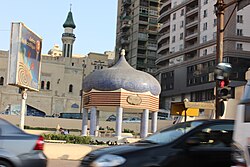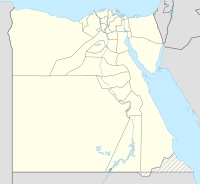Sidi Bishr (Arabic: سيدي بشر) is a neighborhood in the Montaza District of Alexandria, Egypt. Established as a summering site by the Egyptian middle class before the Revolution of 1952, it has since become one of the largest neighborhoods of the city.[1]
Sidi Bishr
سيدي بشر | |
|---|---|
 Sidi Bishr, 2015 | |
| Coordinates: 31°15′07″N 29°59′40″E / 31.252066°N 29.994464°E | |
| Country | |
| Governorate | Alexandria |
| Time zone | UTC+2 (EST) |
Overview
editThe Coptic Orthodox Church of Saint Mark and Pope Peter—known locally as the Church of the Two Saints—located in Sidi Bishr, was the target of the 2011 Alexandria bombing on 1 January 2011; formerly suspected to be the work of terrorist group the Army of Islam, the Chief Prosecutor of Egypt has since accused the Interior Ministry of carrying out the bombing.[2]
On 10 February 2015, the police headquarters of Montaza District was the scene of five bombs which exploded, injuring many civilians. Years after the Revolution of 2011, Muslim Brotherhood continue to respond to Morsi's overthrow and to the crackdown on members of their organization.[3]
History
editDuring World War I, there was an internment camp at Sidi Bishr, and Manwel Dimech was imprisoned there.[4] During the war it was also the scene where the Mediterranean Forces camped and trained and occasionally enjoyed the waters of Sidi Bishr, where the coast wasn't so rocky.[5]
In 1928, Sidi Bishr was a picturesque place on the edge of the desert and a decade later had been transformed with the extension of The Corniche. People visited Sidi Bishr's three beaches from around the world, making it cosmopolitan and a fashionable place to be.[6] Lawrence Durrell's Justine describes the beach at Sidi Bishr as "a place where beautiful women from all over the world donned bikinis".
Since the Egyptian revolution of 1952,[7] women no longer wear bikinis to public Egyptian beaches.[8][9]
See also
editReferences
edit- ^ Amin, Galal (2000). Whatever Happened to the Egyptians? Changes in Egyptian Society from 1950 to the Present. Cairo: American University in Cairo Press. ISBN 977-424-559-8.
- ^ Ismail, Farrag (February 7, 2011). "Ex-minister suspected behind Alex church bombing". Al Arabiya News. Archived from the original on January 20, 2013.
- ^ "Bombs wound 10 civilians in Egypt's Alexandria". Yahoo! News (AFP). February 10, 2015. Retrieved 14 November 2016.
- ^ Zarb-Dimech, Anthony (November 22, 2009). "The Prisoner of war camps in Egypt (1914-1921) – An album by Juann Mamo - The Malta Independent". Malta Independent. Archived from the original on November 13, 2016.
- ^ Spring, F.G. (March 1, 2009). The History of the 6th (Service) Battalion Lincolnshire Regiment 1914 - 1919. Lulu. ISBN 9780955991417. Retrieved 14 November 2016.
- ^ Hagg, Michael (2008). Vintage Alexandria: Photographs of the City, 1860-1960. American Univ in Cairo Press. ISBN 9789774161926.
- ^ "Arab Unity: Nasser's Revolution". Aljazeera. June 20, 2008. Archived from the original on 13 November 2016. Retrieved 14 November 2016.
- ^ Lagnado, Lucette (July 19, 2013). "Lawrence Durrell's 'Justine': Missing Alexandria". Wall Street Journal. Archived from the original on July 29, 2017.
- ^ Athanasiadis, Iason (January 23, 2014). "Alexandria, once a glamorous seaside resort, now a crumbling city". The National AE. Archived from the original on 30 September 2016. Retrieved 14 November 2016.
